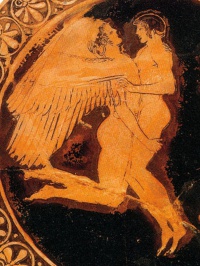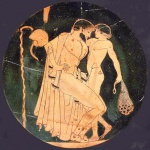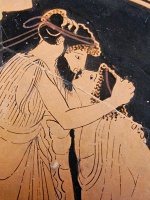Spartan pederasty

Spartan pederasty, the traditional intimate and pedagogic friendship between a man and an adolescent boy, a custom held in common with other Dorian tribes, is thought to have either been introduced at the time of the Dorian invasion, around 1200 B.C., or to have been instituted in the seventh century B.C. in emulation of that in Crete, which had evolved in response to population pressure. Sparta is thought to be the first city to practice athletic nudity, which evolved in parallel with formal pederastic practices.[1]
Structure
| Part of the boylove history series |
 |
| Portal:History |
The Spartans believed that the love of an older, accomplished aristocrat for an adolescent boy was essential to his formation as a free citizen. The education of the ruling class was thus founded on pederastic relationships, required of each citizen.[2] The ephors fined any eligible man who did not love a boy, because, despite his own excellence, he failed to make a beloved “similar to himself.”[3] Likewise, for a boy it was a disgrace to not find a lover,[4]. By the time they reached the age of twelve "there was not any of the more hopeful boys who did not have a lover to bear him company."[5]
In Sparta, like in most other Greek city-states, the man first had to win the affection of the boy he sought, and it was the boy’s right to choose his lover. But in Sparta, his freedom was not complete. If two men, both reputable but one rich and the other poor, courted him, and he settled on the wealthier of the two, he was fined by the ephors for his greed.[3] As for the men, if two different men both loved one boy, instead of becoming rivals they forged a friendship between themselves, and "worked together to make the boy the best he could be."[6] Another characteristic that set Spartan boys apart from other Greek youths was that they were the ones to request to be mentored.[7]
Erotic aspects
Though Plato in his Laws implies otherwise in asserting that the Spartan custom of males taking sexual pleasure with other males was 'παρά φύσιν' "beyond nature"[8], many ancient writers held that Spartan pederasty was chaste, though still erotic. Lycurgus decreed that if someone, being himself an honest man, admired a boy's soul and tried to make of him an ideal friend without reproach and to associate with him, he approved, and believed in the excellence of this kind of training. But if it were clear the attraction lay in the boy's bodily beauty, he banned the connection as an abomination; and thus he mandated that "erastes should abstain from boys just as parents abstain from sexual intercourse with their own children." This system, implies Xenophon, produces the most modest, trustworthy and self-controlled men in all of Greece. [9]
Those who hold that carnal relations were excluded nevertheless depict the relations as sensual. Januarius Nepotianus, for example, holds that the Lacedemonians permitted kisses and sleeping together as long as the two were separated by a sheet.[10]
Plutarch also describes the relationships as chaste, and states that it was as unthinkable for a lover to sexually consummate a relationship with his beloved as for a father to do so with his own son. In the same vein, Cicero asserted that, "The Lacedaemonians, while they permit all things except outrage (stuprum, = Greek hubris, referring here to anal intercourse)[11] in the love of youths, certainly distinguish the forbidden by a thin wall of partition from the sanctioned, for they allow embraces and a common couch to lovers.' [12] Aelian goes even farther, stating that if any couple succumbed to temptation and indulged in carnal relations, they would have to redeem the affront to the honor of Sparta by either going into exile or taking their own lives.[7]
The construction of Spartan pederasty as exclusively chaste conflicts with epigraphic writings found on the island of Thera in 1898, an island colonized by the Spartans. These are graffiti, preserved on the rocks of a cliff in the vicinity of what became a gymnasium. They record sexual conquests, always of one male over another[13]. E.g.:
IG 12(3).538b Ἀμο[τ]ίωνα ὦιπ<h>ε Κρίμων [τ]ε(ῖ)δ[ε] "Krimon fucked Amotion here" (the verb οἴφω is exclusively physical). Thera, however, was also influenced by Crete, a culture which did not privilege non-sexual relationships.[14] The alleged sexual indulgence of Spartan pederasty was a running gag in the repertoire of Athenian comedians, and the verb λακωνίζω / lakōnízō ("to do it the Lacedaemonian way"; literally, "to laconize") took on the meaning of "to sodomize." It is not clear to what extent this is a reflection of the enmity between Athens and Sparta.
Military aspects
Pederasty and military training were intimately connected in Sparta, as in many other cities. The Spartans, claims Athenaeus [15] sacrificed to Eros before every battle: "Thus the Lacedaemonians offer preliminary sacrifices to Eros before the troops are drawn up in battle-line, because they think that their safe return and victory depend upon the friendship of the men drawn up." However, unlike other cities which stationed lovers side by side in battle to encourage each to fiercer efforts, Spartan youths were so well trained that they fought nobly regardless of where they were positioned.[16]
The lover was responsible for the boy's training. An anecdote relates the story of a Spartan magistrate who was fined by the city because his beloved had cried out while he was fighting, which was considered to be a sign that the young man was overly effeminate and had therefore not been properly educated by his distinguished lover.[5] And while the ephors were lenient with a youth who committed a misdemeanor, they made sure to punish his lover, since it was his responsibility to watch and control his beloved.[3]
Festivals and religion
The Hyacinthia, the second most important Spartan festival, was celebrated in summer at Amyclae. It honored Hyacinthus, the mythical young prince of Sparta and beloved of Apollo. The festivities continued for three days, with the first mourning the death of Hyacinthus and the last two celebrating his rebirth and the majesty of Apollo. It has been suggested that the cycle symbolizes the development of a youth in such relationships, in which he dies as a child in order to be reborn as an adult.
The Gymnopaedia were yearly Spartan dances by naked boys, with attendance originally restricted to married men.
Elacatas was another pederastic Spartan hero, held to have been one of the eromenoi of Heracles. He was honored with a sanctuary and yearly games. The myth of their love is an ancient one.[17]
Notes
- ↑ Thomas F. Scanlon, "The Dispersion of Pederasty and the Athletic Revolution in Sixth-Century BC Greece," in Same-Sex Desire and Love in Greco-Roman Antiquity and in the Classical Tradition of the West, ed. B. C. Verstraete and V. Provencal, Harrington Park Press, 2005, pp.64-70
- ↑ Erich Bethe,Die dorische Knabenliebe: ihre Ethik und ihre Idee, 1907, 441, 444
- ↑ 3.0 3.1 3.2 Aelian, Var. Hist., III.10
- ↑ Cicero, De Rep., iv. 3
- ↑ 5.0 5.1 Plutarch, Lives, "Lycurgus"
- ↑ Plutarch, Lycurgus, 18.4
- ↑ 7.0 7.1 Aelian, Var. Hist., III.12
- ↑ Plato, Laws, 636b
- ↑ Xenophon, Constitution of the Lacedaemonians, II.13-14
- ↑ Januarius Nepotianus, XV.20
- ↑ John Addington Symonds, A Problem in Greek Ethics, V; 1883
- ↑ Cicero, De Rep., iv. 4
- ↑ William A. Percy, Pederasty and Pedagogy in Ancient Greece, Chicago, 1996; p.31
- ↑ Ibid. p.53 N.36
- ↑ Athenaeus of Naucratis, The Deipnosophists, XIII: Concerning Women
- ↑ Xenophon, Symposium, 8.35
- ↑ Sosibius, in Hesychius of Alexandria's Lexicon, per Sergent, 1986, p. 163


